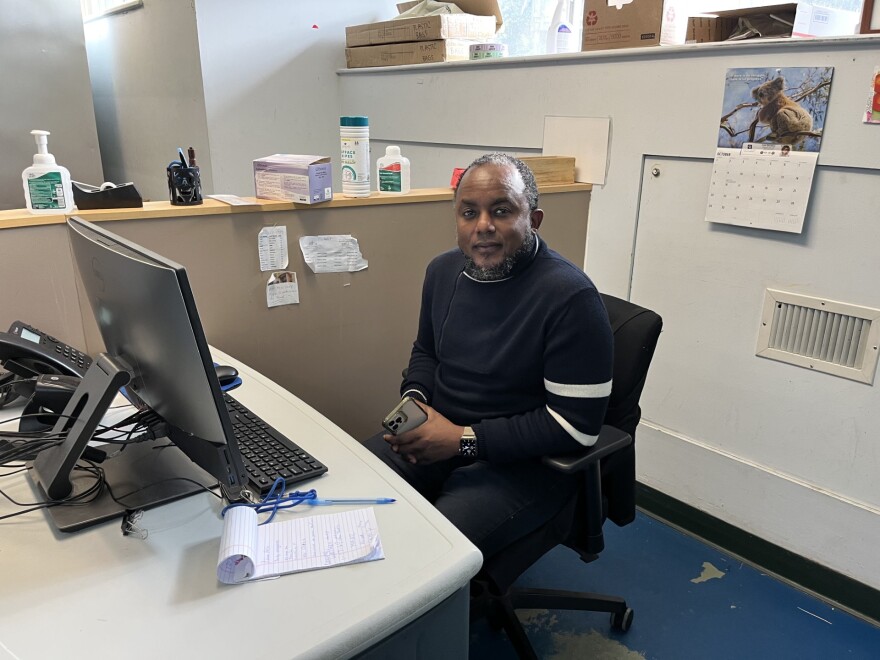Inside Feeding Chittenden, a food shelf located in the Old North End of Burlington, colorful murals dot the walls. Baguettes and fresh veggies fill the shelves of the space, which looks like a small grocery store.
Edi Abeneto, Feeding Chittenden’s supervisor, greets up to four families at a time and welcomes them into the food shelf. He started at Feeding Chittenden as an interpreter in 2004. He speaks five languages, which has made him very valuable to have at the front desk.
And recently, these services have become even more essential. Abeneto says Feeding Chittenden is seeing an uptick in the number of visitors using their services.
“We have a number that's increased now,” he said. “We’re seeing a lot of people coming here.”

One of their customers, Nicholas Peters, is grateful for the service. Peters says he’s been unhoused in Burlington for the past two years.
“I’d starve if it wasn’t for them, so I mean it's a great resource to have in the community,” he said.
But it isn’t just people experiencing homelessness who have been using the food shelf’s services.
Marie Baptiste is a nursing student and works full-time. She said the price for certain foods has gotten so high, it’s driven her to come here for things like bread and fresh produce.
“When you’re in need, you don’t want people to put you down, so this is one thing they don’t do here. Which is really nice,” Baptiste said.
“When you’re in need, you don’t want people to put you down, so this is one thing they don’t do here. Which is really nice."Marie Baptiste
A new federal report released last month finds hunger in the U.S. rose sharply last year. Many of Vermont’s charitable food providers have said 2023 hasn’t been any better.
The Upper Valley Haven, a food pantry located in Hartford, is one of the many Vermont pantries that’s seen a similar increase in demand.
“We can't say exactly what is happening behind the scenes of what is leading to this increase, but it is dramatic, and it is present,” said Michael Redmond, the Haven’s executive director.
Morgan Bertholdt, the Haven’s registration coordinator, said many clients have cited the same reason for seeking extra help: a tighter budget.
“A lot of people have mentioned the cuts with food stamps, some families are only getting $25 to $30 per month, and that's barely a bag of groceries nowadays,” Bertholdt said.
In March, a pandemic-era boost in extra government funding for food stamps, also known as 3SquaresVermont, ended.
The financial impact on Vermont families has been huge, according to John Sayles, the CEO of the Vermont Food Bank.
“When that ended across the country, the average loss for a Vermont family was $500 a month, and this was at the same time that food inflation was taking off,” Sayles said.
Cuts to food stamps isn’t the sole reason for increased food insecurity. Meredith Niles, an associate professor and food security expert at the University of Vermont, said it’s a combination of things.
“You sort of have this perfect storm of a lot of issues where a lot of additional relief programs are coming to an end, and food inflation has increased significantly in 2022, and wages have not necessarily kept pace,” Niles said.
And that’s been the overall message: the flooding this summer, the food stamp budget cuts, a tight housing market, these have all meant it’s hard to pinpoint the exact reason why charitable food providers are seeing a prolonged uptick in need.

One of the hopes is that more food stamp funding could be on the way via the 2023 Farm Bill. Renewed approximately every five years, the farm bill determines policy and funding levels for agriculture, food assistance programs, natural resources, and other aspects of food and agriculture under the U.S. Department of Agriculture, or USDA.
Sayles, with the Vermont Food Bank, said much of the discussion around food stamp funding has become political.
“The fight over the farm bill, where the food stamp levels are set, really is about the dollars,” Sayles said. “Depending on your political party, there are points of view of discouraging work by making food resources available.”
Sayles said he believes the extra funds do the opposite.
“Other people in Congress also say that [food stamps] help people’s ability to work, and that’s certainly something that I believe,” Sayles said.
With a possible government shutdown looming, Sayles doesn’t think it’s all too likely that the Farm Bill will pass through this year, and he’s not sure when the need in Vermont will cool off.
“I honestly, I wouldn't venture a guess on whether this one's going to take 10 years or five years or 20 years,” Sayles said.
This story is a collaboration between Vermont Public and the Community News Service. The Community News Service is a student-powered partnership between the University of Vermont’s Reporting & Documentary Storytelling program and community newspapers across Vermont.
Have questions, comments or tips? Send us a message.





